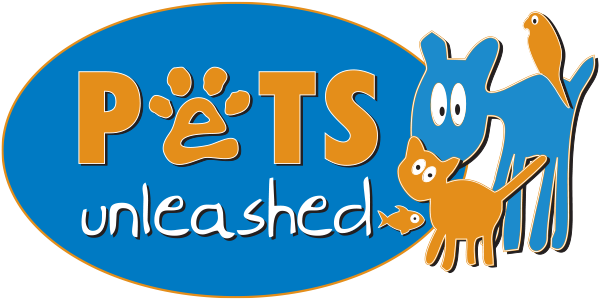Bearded Dragon
Getting a Bearded Dragon can seem confusing. At Pets Unleashed we have created this easy to follow check list to help navigate through some of the set up requirements.
- Terrarium: When purchasing and setting up your terrarium you should keep in mind the size your animal will grow to and their lifestyle. As dragons are good climbers it is recommended that you provide structures for climbing (branches, platforms, and rocks) and vegetation to hide in. Synthetic plants and driftwood logs are useful for this as they are sanitary and easily cleaned. A fully grown Bearded Dragon will require an enclosure that is about 120cm long and about 45cm high as a minimum. A smaller terrarium can be used for young dragons but must be upgraded before they have outgrown it to prevent any health or growth problems.
- Heating: A temperature range between 28°C-35°C during the warmer months and 22°C-28°C during the cooler months should keep your pet happy and healthy. Heat is best provided from a ground level and a basking spot light. Under-enclosure heat mats are good ways of providing heat at ground level and infrared heat globes or ceramic heat globes are ideal for a basking spot. Basking spots are best turned off during the night period but the substrate heater should stay on. All heating products should be controlled by a thermostat to prevent overheating and should be kept to one side of the enclosure.
- Lighting: To supply your Dragon with enough UVB light to keep them healthy a globe of at least 10% spectrum should be installed within or above your enclosure and set on timer to replicate day lengths. Be sure to protect your Dragon from harm by enclosing any internal globes within a wire cage.
- Thermostat: Adding a thermostat to your terrarium is the easiest way to ensure all heating requirements are met. These helpful tools measure the temperature at the point of probe and control the heat supply to prevent burns or power wastage. Some more advanced units will alarm if the temperature drops below a set level warning you about possible faults in the heating supplied.
- Thermometer/Hygrometer: These should be installed as a method of checking that the heating is working and to ensure that it is not too humid or too dry.
- Water and Food Dishes: Water dishes are to be big and deep enough for your Bearded Dragon to soak in without flooding your enclosure but not so big that a pet could potentially drown. You can also had some larger pebbles to water dishes for young lizards to rest on. A shallow food dish is best to allow easy access to food, while deep dish may be needed if feeding live food to prevent food escaping into the terrarium.
- Furnishings: Climbing structures such as logs and rocks are beneficial to your Dragon for exercise, prime basking sites and also as a rough surface to rub against when shedding their old skin. Leaf litter and/or canopy style foliage is useful for hiding and adds to the appearance of your enclosure. A hide area is also a must. It is important anything you add to your terrarium is clean and parasite free with most dragons available never being exposed to external disease found in the wild. To prevent burning your Dragon rocks should never be place below a basking light, Real rocks can heat up to extreme temperatures.
- Substrate: A loose style substrate is best to allow your bearded dragon to shuffle about in the litter and exercise the muscles in their feet. Reptile bark, aquarium gravel, sanitized leaf litter, desert sand or pet litters are some of your many options. A daily check and removal of feces is required to prolong the life of your substrate and a complete change (or clean in the case of the gravel) should be carried out every 6 to 8 weeks or whenever needed.
- Food: Bearded Dragons require to be fed daily, specialised Dragon pellet diets are available on the market and offer a complete diet. You should however supplement your Dragon’s diet with fruit (no acidic fruits such as citrus, pineapple, kiwi), vegetables (endive, broccoli, carrot, silver beet) and insects (crickets, meal worms, earthworms, fly lavae, silkworms, wood roaches) regularly. Water should also be changed daily due to commonly bathing and drink from the same source.
- Tools: Feeding tongs, cricket boxes and/or cricket feeders are helpful when it comes to feeding your pet.
- Supplements: Calcium and vitamin supplement powders need to be added to food (excluding pellets) to ensure the good health of your pet. This is even more so important if you have a female who is potentially getting ready to lay eggs. A female dragon may lay eggs even without the presence of a male.
- Cleaning: To further ensure the health of your Bearded Dragon, appropriate cleaning methods should be followed when cleaning your enclosure. Reptile Cleanning sprays or wipes for cage cleaning are best as they are formulated to ensure there is no infestation with mites or other problems.
- Treatments: Hopefully shouldn’t be necessary but in the chance of a mite infestation, mite sprays for the enclosure and furnishing are available. The directions on the packaging should always be followed and if required speak with a vet.
Handling:
It is recommended before purchasing your Bearded Dragon to have a demonstration on the best way to hold juvenile and adult
Bearded Dragons. IT IS IMPORTANT TO WASH YOUR HANDS BEFORE AND AFTER HANDLING BEARDED DRAGONS.
Seek advice from a specialist reptile veterinarian for all health issues.
It is illegal to remove native reptiles from the wild in Australia without the appropriate Government permits, please check your states
regulations on the appropriate permits to enable you to keep captive bred reptiles. Please do not release any captive reptiles into the
wild as this will disrupt the natural order of our environment.
